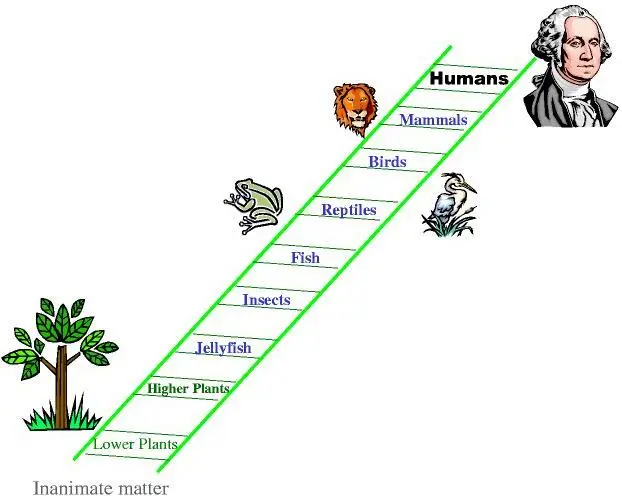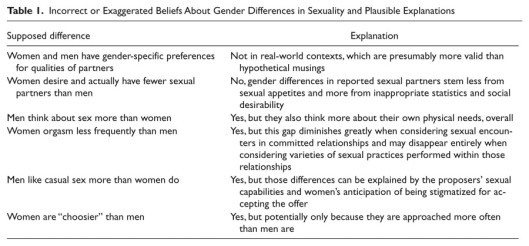Tags
bias, biology, culture, Education, interaction, Popular science, science, science and society, Science in Society, society
In these “enlightened” times, people often try to use science to justify their social, political or ideological positions. While the influence of scientific research on our world view is commonly recognized, the converse dynamic gets far less attention. Cultural factors shape the sort of questions we ask and how we choose to interpret the answers; for example, despite the claim that the idea of evolution has radically altered our view of ourselves, it also often serves to reinforce existing social and cultural norms. Here are five commonly accepted biological “facts” which are untrue but are used to justify our conception of ourselves and our place in the world.
MYTH: Humans evolved from chimps.
FACT: Humans evolved alongside chimps.
It may seem like semantic nit-picking, but the difference is crucial — and it both shapes and is shaped by our conception of ourselves and our closest relatives. The statement that humans evolved from chimps isn’t correct at all, not even in a vague approximate kind of way. Humans did not evolve from chimps; humans, chimpanzees and gorillas have all evolved from a common ancestor which we shared sometime around 8-10 million years ago. At the moment, the most likely candidate for this common ancestor is the Nakali ape (Nakalipithecus nakayamai), which is known from a recent fossil found in Kenya’s Rift Valley.
Some people might try to cling to a sliver of truth by arguing that humans should be considered different from other great apes because we look very different from them. In fact, chimps, gorillas and orang-utans also look quite different from one another; the only reason we lump them all together is that they have fur and we don’t. Hairless chimpanzees like Cinder or Ashes don’t really look that different from humans. Given that, there’s really no justification for distinguishing humans simply based on our hairlessness (which may have been an adaptation to help us keep cool while running long distances).
Besides, looks aren’t everything. A recent study poses another challenge to our naïve view that humans have “evolved more” than other apes: chimpanzees seem to have undergone more directional selection than humans since we split. Of course, there’s a lot more to evolution than just directional selection, but the point remains. Humans are apes; we evolved alongside chimps, gorillas and orang-utans, not from them.
MYTH: Humans are different from animals.
FACT: Humans are animals.
This is wrong in two ways, one simple and the other subtle. The simple mistake is failing to recognize that humans are animals. There’s no need to belabour this point: humans are animals, pure and simple.
The subtle mistake is to think that this mess can be corrected by the additional word “other” to get “Humans are different from other animals”. While this statement is without a doubt true, it’s also trivial and misleading. Any species of animal could be described as “different from other animals” (and the same could be said of plants); it would be a mistake to be misled by this into thinking that humans are somehow exceptional. Although there is certainly a good deal of value in trying to identify and understand traits that are unique to humans, it’s important to realize that the same could be done from any other perspective. To quote Richard Dawkins, if elephants were researching evolution, they might be obsessed with finding species which ‘have crossed the nasal rubicon and taken the final leap to full proboscitude.’ While there are certainly several traits that are unique to our lineage, we shouldn’t allow that to tempt us into thinking we are somehow exceptional. Like every other kind of life on Earth, we may be unique but we are not special.
It’s also important to remember that we keep discovering that traits which we thought were uniquely human turn out to be more widespread. One example which I recently described is ravens’ use of referential gestures; others include evidence of empathy in elephants, cultural transmission in dolphins and learning in ants.
MYTH: Higher organisms evolved from bacteria.
FACT: There’s no such thing as evolutionary progress; we’re all just running in place.
We often use metaphors when describing the course of evolution or the relationship between different organisms. While it’s fair to say there’s a difference in complexity between multi-cellular and unicellular creatures, loaded terminology like “primitive” and “higher” introduces value judgements. There’s nothing at all primitive about any bacteria you might run into — they’re all thoroughly modern creatures, having evolved continuously for the last few billion years. Similarly, there isn’t any sense in describing specific types of mammal as “higher” and “lower” mammals; it’s also ridiculous to call mammals “higher” (or “more evolved”) than reptiles or amphibians. Evolution doesn’t have a direction, a goal or a hierarchy.
The metric we use to judge which creatures are “higher” and “lower” says a lot about the true relevance of this scale: the more closely a group resembles humans, the “higher” it is. This sort of attitude, which is all too common even among biologists, simply reflects our own age-old arrogance; it’s really just the scala naturae ported to a biological framework.

 The mistake here is to think that something that evolved earlier is more primitive, which isn’t true. The fact that bacteria arose earlier during the history of life on Earth doesn’t make them somehow less complex or primitive. All the species alive today have evolved and adapted to find its way through the world long enough to produce offspring; all are “equally evolved”. In the context of biology, newer isn’t necessarily better; evolution isn’t a process of gradual refinement towards an improved version, but rather a question of stumbling along just well enough to make it into the next generation.
The mistake here is to think that something that evolved earlier is more primitive, which isn’t true. The fact that bacteria arose earlier during the history of life on Earth doesn’t make them somehow less complex or primitive. All the species alive today have evolved and adapted to find its way through the world long enough to produce offspring; all are “equally evolved”. In the context of biology, newer isn’t necessarily better; evolution isn’t a process of gradual refinement towards an improved version, but rather a question of stumbling along just well enough to make it into the next generation.
The view that evolution somehow involves progress is as profoundly incorrect as it is common. There is no such thing as “evolutionary progress”; evolution is more like an arms race than march of progress. An excellent analogy used by some biologists is the Red Queen (from Lewis Caroll’s Through the Looking Glass): we’re all running as fast as we can just to stay in place.
MYTH: You are a distinct, coherent individual.
FACT: Your individuality comprises an ecosystem.
We like to think of ourselves as coherent individuals, but this isn’t necessarily true. Of course, one problem with this is the old “Delphic boat” paradox — we replace most of the cells in our body during the course of our life (and also undergo huge psychological changes), so how can we be the same individual? That’s an entertaining and intriguing philosophical quandary, but I actually want to make a different point based on our biology.
Your skin, gut and mouth (and that of every other human) are teeming with thousands of different kinds of bacteria. In fact, there are ten times more microbial cells than human cells in the average adult body. In other words, when measured by number of cells, the human body is 90% microbial cells and only about 10% animal (human) cells. These microbes also represent a vast source of genetic information. The Human Microbiome Project has identified over 29,000 novel, unique proteins from only 178 species so far; by comparison, the human genome only has about 23,000 genes. While some of these critters seem to play an important role in our health and well-being, the truth is that we simply don’t know what (if anything) most of them do, besides making a comfortable living in or on our bodies without doing enough harm to cause a ruckus. Of course, it’s probably a bit more complicated than that; for example, Helicobacter pylori, a gut bacteria known to cause gastric ulcers, has recently been found to protect against allergy-induced asthma. The importance of our gut flora is an exciting and active field of research at the moment, with a recent study suggesting that our microbiota may impact aspects of our health ranging from obesity to immune response.
It’s been said that “no man is an island”, but now we have to contend with the fact that we are not even individuals, but rather landscapes supporting a vast ecosystem of bacteria, fungi and viruses. And “landscape” probably is the best description since, strictly speaking, your gut, lungs, etc are exterior surfaces of your body.
MYTH: Men are from Mars; women are from Venus.
FACT: Men are from Earth; women are from Earth. Deal with it.
This seems like such an obvious, resonant truth, doesn’t it? Of course, it’s important to remember that stereotypes aren’t always true…but bearing that in mind, men certainly do seem to think about sex more, don’t they? Women tend to be more choosy than men, who sleep around a lot more. Sure, some part of this might be due to social conditioning…but men and women are still basically different, right? After all, it makes sense: millions of years of evolution shaped men into horny creatures that will scatter their sperm everywhere and women into choosy creatures with an instinct to nurture and nurse their young. Right?
Wrong. The logic seems sound, but unfortunately it isn’t based in facts. Men and women don’t actually seem to have any significant differences in sexual attitudes or activity. Here’s the table of conclusions from the study by Conley:
 To expand on the first few points just a bit:
To expand on the first few points just a bit:
- Gender preferences for partners disappeared when they considered actual or current partners, rather than an ideal.
- On average, men reported a preference for more partners, but this turned out to be because of a few men who wanted lots of partners, skewing the average; when you look at the median preference (or central tendency) for each group, the difference disappears.
- Men report having more sexual partners than women. However, this difference disappears when they are connected to a (fake) polygraph — men seem to exaggerate about how many partners they’ve had, perhaps to meet some social expectation.
- Men tend to think about sex more often than women, but they also think about food and sleep more often. In other words, men think about their personal needs more often than women do, perhaps because they are socialized to be “agentic and self-focused”.
Greg Laden has also written an excellent blog post about the origins of gender and sexual orientation. I particularly like his point that a (simplified) combination of N factors influencing gender would lead to 2N possible genders. As he put it:
The interesting thing about this is that a cursory examination of potential human gender diversity from a purely biological point of view suggests that there are at least dozens of “genders” but the vast majority of cultures define (or even allow) only a few. Perhaps culture, in this case, is more restrictive than biology. Which, to a behavioral biologist, is not much of a shock, though it might be if considered from a broader social science perspective.
Men and women are different because we choose (consciously or not) to raise them differently. We show different expectations and provide different role models for them; we reward and chastise them differently. I can’t resist the opportunity for a quick digression about how we dress children. Our modern habit of dressing boys in blue and girls in pink actually dates from around the baby boomer generation; before then, the tendency was the opposite (or just plain white clothes for infants). Here’s a quote from an early 20th century publication:
“The generally accepted rule is pink for the boys, and blue for the girls. The reason is that pink, being a more decided and stronger color, is more suitable for the boy, while blue, which is more delicate and dainty, is prettier for the girl.” — Infants’ Department, 1918
It was also common for young boys to wear a dress for the first few years (until they were “breeched“). Here’s a photo from the Smithsonian showing Franklin D. Roosevelt when he was about 3 years old:
I’d like to stress that my main point isn’t actually about whether or not men and women are identical. Although I have certainly argued against the idea that gender roles are the results of significant and relevant biological factors (i.e., that gender roles are “natural”), my main point is that this is a particularly striking example of an area where preconceptions can and do have a strong effect on what kind of research is done and how we evaluate and respond to the results. It’s far to easy to gild our social choices with wishy-washy science (in this case, evolutionary sociobiology) in an attempt to justify them. The very act of asking certain questions instead of others requires decisions that will inevitably reflect the social, political and ideological dynamic of the humans involved.
My Own Bias
Given that this post is supposed to highlight the relationship between science and socio-cultural factors, it would be remiss to ignore my own bias. The decision to write about the interaction between science and society is, clearly, a political decision. In choosing which “myths” to present, I inevitably project my own views about the world (or how it could/should be). I might have chosen to address any range of subjects, but I wrote about some things that matter to me (for whatever reason). We like to think that science provides some kind of objective truths, but which questions we ask and how we report and interpret the results will always be affected by our social, cultural and political filters. The scientific endeavour, though a profound and valiant undertaking, is nevertheless a quintessentially human one.


Sedeer! This is super interesting and even though I have absolutely no background in anything whatsoever science related, I was completely engaged from start to finish. Well… I’m not going to lie there were a few (several) moments when I had to look things up. Do you think in the future you’ll possibly expand on them later?
I’m really glad you enjoyed the post! 🙂 I don’t have any concrete plans to revisit this, but I’m happy to if you’d like…and I’m sure the themes will be woven into my writing anyway. If there’s something in particular you want to know more about, let me know and I’ll do my best to expand on it.
What’s evolution… just kidding. Maybe you could talk a little bit more on directional selection?
Sure! I’ll put together a post about different kinds of selection and their role in evolution….hopefully I can help clear up your confusion.
Edit: Here’s the post; it will be the first in a series.
Great work Sedeer.Very good presentation of these points.As you suggest many of these misconceptions result from a cultural bias and your corrections result from bio.-scientific proposals. We agree on most of the points you considered and definitely they make very good research subjects.Cultural conception and structures do effect the process of adaptation and interface with the environment in being the opposing force to that of the environment.So I suppose they could influence the resulting synthesis whether it is cultural representation or biological mutations.i.e if you believe in the classical causality .
I just want to mention few points here:
You have missed the most basic and powerful misconception and myth that Humans construct their rational upon,which is placing ourselves as Gods separate from nature or reality.
In your third point,we are all running in the SAME place.(you do explain it later)
I like your fourth point .It brings out the picture of the interconnectedness of all reality although you do not expand on it.Whatever ´IT`is,all structures and forms are made of it.
The last point also carry many cultural trends and taboos with it.You should tell us of how the ant worker think of her queen or the male in the colony.Maybe the queen should wear pink and the male wear blue.I would like you to recommend some literature on the split from cloning to sexual propagation.Thanks
Great work Sedeer,you should build up on this.
Pingback: » An eBay for science
Pingback: Current Events In Science | Living History
The last point on gender reminded me of that old sesame street segment. One of these things is not like the other. In the sense that the ‘science’ in the final section was far too subjective to take seriously. Perhaps more citations or a treatment as consistent as the other points, which were presented in a clearer fashion. It seemed to me the author was trying to convince us of the last point rather than presenting good science. Either way, a cute essay overall. I get most of the misconceptions and a few others asked of me by students..usually in a much more creative way, but the misconceptions about framing evolution is at the center. I have more people incorrectly claiming to ‘believe in evolution’ as opposed to understanding the state of the field, the assumptions that are made and how inconsistencies are explained. They are content with not understanding the details, but believing it, without properly understanding evolution.
You’re right, the last “myth” is defintely the weakest one. It’s partly there to provoke a reaction (which it usually seems to do) since I think many people are likely to agree/disagree with it and interpret the research and results depending on what preconceptions they bring to the discussion. That’s also why it’s the last myth — right before I discuss my own bias in writing this post. 🙂
Having said that, if I were to rewrite this post, I would consider revising the last point. It certainly reflects my own views on the subject quite stronly and I think I had fun with it rather than making the effort to provide proper critical support. I do think the question of gender identiy/roles is a serious one worthy of proper consideration, which is why I linked to Greg Laden’s post.
I’ve also encountered lots of people who “believe in” evolution and are often (unfortunately) quite willing to make claims about evolution or use it to justify an argument without actually properly understanding it. I’m writing a series of posts to try to address this; if you’re interested, check out the “Natural Selection” series in the top menu.
Thanks for your comment!
“Although I have certainly argued against the idea that gender roles are the results of significant and relevant biological factors (i.e., that gender roles are ‘natural’)”
Unless it is posited that gender roles come from supernatural events, the ONLY place they come from is natural factors, biological in this case. All of human culture, whether one likes it or not, is natural, as natural as anything else that goes on in the biosphere.
The great irony here is that the author is indulging in the very anthropocentric bias he laments in that he is artificially separating human beings (labeling our culture and biases “unnatural”) from the natural order.
A more effective analysis would recognize that human gender stereotypes (which fall across a spectrum, as the author notes, in geography and time) are 100% derived from the interactive neurophysiology of our species: culture. That places it in the realm of science and it can be studied more objectively, instead of simply ranted about.
You’ve focused on the word “natural”, which I intentionally put in quotes and parentheses. Since I don’t believe in the supernatural, I absolutely agree that gender roles are natural, just like everything else in exsitence from ant nests to space stations and black holes. I’ve never liked the use of “artificial” to mean man-made things, whether cultural or physical. However, many people do use the word “natural” as the opposite of “man-made”, which is why I included it in an aside.
The point I was raising (just before the parentheses) is whether gender roles are the result of “significant and relevant biological factors”. Our biology certainly constrains and influences our culture, but I think the claim that culture can be fully reduced to biology is quite a strong position, akin to saying that biology is nothing but physics (or chemistry). Some aspects of our culture may be heavily influenced by our biology (eg, a preference for long-term mating relationships that form a pair-bond) and others less so (eg, how we greet one another — handshake, bow, kiss?). The question is to what extent gender roles are biologically determined and so which field of science is best suited to addressing and explaining them — sociobiology, anthropology, social psychology, some/all of the above?
Pingback: Do ants really count their steps? « Inspiring Science
Pingback: Do Ants Really Count Their Steps? | UA Magazine
Pingback: 7 myths you “learned” in biology class that you probably still believe | Unhinged Group
Pingback: 7 myths from biology class that most people still believe. | | MAJORPRESS